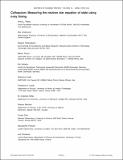| dc.contributor.author | Watts, Anna L. | |
| dc.contributor.author | Andersson, Nils | |
| dc.contributor.author | Chakrabarty, Deepto | |
| dc.contributor.author | Feroci, Marco | |
| dc.contributor.author | Hebeler, Kai | |
| dc.contributor.author | Israel, Gianluca | |
| dc.contributor.author | Lamb, Frederick K. | |
| dc.contributor.author | Miller, M. Coleman | |
| dc.contributor.author | Morsink, Sharon | |
| dc.contributor.author | Özel, Feryal | |
| dc.contributor.author | Patruno, Alessandro | |
| dc.contributor.author | Poutanen, Juri | |
| dc.contributor.author | Psaltis, Dimitrios | |
| dc.contributor.author | Schwenk, Achim | |
| dc.contributor.author | Steiner, Andrew W. | |
| dc.contributor.author | Stella, Luigi | |
| dc.contributor.author | Tolos, Laura | |
| dc.contributor.author | van der Klis, Michiel | |
| dc.date.accessioned | 2018-07-20T15:22:58Z | |
| dc.date.available | 2018-07-20T15:22:58Z | |
| dc.date.issued | 2016-04 | |
| dc.identifier.issn | 0034-6861 | |
| dc.identifier.issn | 1539-0756 | |
| dc.identifier.uri | http://hdl.handle.net/1721.1/117028 | |
| dc.description.abstract | One of the primary science goals of the next generation of hard x-ray timing instruments is to determine the equation of state of matter at supranuclear densities inside neutron stars by measuring the radius of neutron stars with different masses to accuracies of a few percent. Three main techniques can be used to achieve this goal. The first involves waveform modeling. The flux observed from a hotspot on the neutron star surface offset from the rotational pole will be modulated by the star's rotation, and this periodic modulation at the spin frequency is called a pulsation. As the photons propagate through the curved spacetime of the star, information about mass and radius is encoded into the shape of the waveform (pulse profile) via special and general-relativistic effects. Using pulsations from known sources (which have hotspots that develop either during thermonuclear bursts or due to channeled accretion) it is possible to obtain tight constraints on mass and radius. The second technique involves characterizing the spin distribution of accreting neutron stars. A large collecting area enables highly sensitive searches for weak or intermittent pulsations (which yield spin) from the many accreting neutron stars whose spin rates are not yet known. The most rapidly rotating stars provide a clean constraint, since the limiting spin rate where the equatorial surface velocity is comparable to the local orbital velocity, at which mass shedding occurs, is a function of mass and radius. However, the overall spin distribution also provides a guide to the torque mechanisms in operation and the moment of inertia, both of which can depend sensitively on dense matter physics. The third technique is to search for quasiperiodic oscillations in x-ray flux associated with global seismic vibrations of magnetars (the most highly magnetized neutron stars), triggered by magnetic explosions. The vibrational frequencies depend on stellar parameters including the dense matter equation of state, and large-area x-ray timing instruments would provide much improved detection capability. An illustration is given of how these complementary x-ray timing techniques can be used to constrain the dense matter equation of state and the results that might be expected from a 10 m2 instrument are discussed. Also discussed are how the results from such a facility would compare to other astronomical investigations of neutron star properties. | en_US |
| dc.publisher | American Physical Society (APS) | en_US |
| dc.relation.isversionof | http://dx.doi.org/10.1103/REVMODPHYS.88.021001 | en_US |
| dc.rights | Article is made available in accordance with the publisher's policy and may be subject to US copyright law. Please refer to the publisher's site for terms of use. | en_US |
| dc.source | APS | en_US |
| dc.title | Colloquium: Measuring the neutron star equation of state using x-ray timing | en_US |
| dc.type | Article | en_US |
| dc.identifier.citation | Watts, Anna L., et al. “Colloquium : Measuring the Neutron Star Equation of State Using x-Ray Timing.” Reviews of Modern Physics, vol. 88, no. 2, Apr. 2016. © 2016 American Physical Society | en_US |
| dc.contributor.department | Massachusetts Institute of Technology. Department of Physics | en_US |
| dc.contributor.department | MIT Kavli Institute for Astrophysics and Space Research | en_US |
| dc.contributor.mitauthor | Chakrabarty, Deepto | |
| dc.relation.journal | Reviews of Modern Physics | en_US |
| dc.eprint.version | Final published version | en_US |
| dc.type.uri | http://purl.org/eprint/type/JournalArticle | en_US |
| eprint.status | http://purl.org/eprint/status/PeerReviewed | en_US |
| dc.date.updated | 2018-05-08T14:05:50Z | |
| dspace.orderedauthors | Watts, Anna L.; Andersson, Nils; Chakrabarty, Deepto; Feroci, Marco; Hebeler, Kai; Israel, Gianluca; Lamb, Frederick K.; Miller, M. Coleman; Morsink, Sharon; Özel, Feryal; Patruno, Alessandro; Poutanen, Juri; Psaltis, Dimitrios; Schwenk, Achim; Steiner, Andrew W.; Stella, Luigi; Tolos, Laura; van der Klis, Michiel | en_US |
| dspace.embargo.terms | N | en_US |
| dc.identifier.orcid | https://orcid.org/0000-0001-8804-8946 | |
| mit.license | PUBLISHER_POLICY | en_US |
